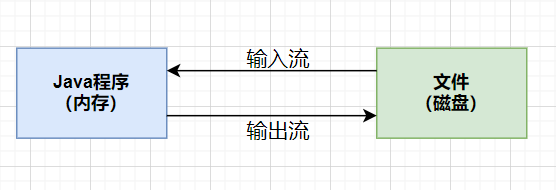IO流(未完待续)
文件
文件流介绍
文件对我们并不陌生,文件是保存数据的地方。
文件在程序中是以流的形式来操作的

流 :数据在数据源(文件)和程序(内存)之间经历的路径
输入流:数据从数据源(文件)到程序(内存)之间的路径
输出流:数据从程序(内存)到数据源(文件)的路径
常用的文件操作
-
根据路径构建一个 File 对象
new File(String pathname)createNewFile()创建新文件String filePath = "e:\\news1.txt"; File file = new File(filePath); try { file.createNewFile(); System.out.println("文件创建成功"); } catch (IOException e) { e.printStackTrace(); } -
根据父目录文件+子路径构建
new File(File parent, String child)File parentFile = new File("e:\\"); String fileName = "news2.txt"; //这里的 file 对象,在 java 程序中,只是一个对象 //只有执行了 createNewFile 方法,才会真正的,在磁盘创建该文件 File file = new File(parentFile, fileName); try { file.createNewFile(); System.out.println("创建成功~"); } catch (IOException e) { e.printStackTrace(); } -
根据父目录+子路径构建
new File(String parent, String child)String parentPath = "e:\\"; String fileName = "news4.txt"; File file = new File(parentPath, fileName); try { file.createNewFile(); System.out.println("创建成功~"); } catch (IOException e) { e.printStackTrace(); }
获取文件的相关信息
- getName 获取文件名
- getAbsolutePath 获取文件绝对路径
- getParent 获取父级file
- length 获取文件的大小(单位是字节)
- exists 是否存在
- isFile 是否是文件
- isDirectory 是否是目录
File file = new File("c:\\Code\\news1.txt");
try {
file.createNewFile();
System.out.println("文件创建成功");
} catch (IOException e) {
e.printStackTrace();
}
System.out.println("文件名字=" + file.getName());
System.out.println("文件绝对路径=" + file.getAbsolutePath());
System.out.println("文件父级目录=" + file.getParent());
System.out.println("文件大小(字节)=" + file.length());
System.out.println("文件是否存在=" + file.exists());
System.out.println("是不是一个文件=" + file.isFile());
System.out.println("是不是一个目录=" + file.isDirectory());
文件创建成功
文件名字=news1.txt
文件绝对路径=c:\Code\news1.txt
文件父级目录=c:\Code
文件大小(字节)=0
文件是否存在=true
是不是一个文件=true
是不是一个目录=false
目录的操作和文件的删除
在 Java 编程中,目录被当作一种特殊的文件
mkdir 创建一级目录,下面给出简略代码
File file = new File("C:\\demo");
file.mkdir()
mkdirs 创建多级目录
File file = new File("C:\\demo\\a\\b\\c");
file.mkdirs();
delete 删除空目录或文件
IO流原理及流的分类
IO流原理
- I/O 是Input/Output 的缩写,I/O 技术是非常实用的技术,用于处理数据传输。如读/写文件,网络通讯等
- Java 程序中,对于数据的输入/输出操作以”流(stream)“的方式进行
- Java.io 包下提供了各种”流“类和接口,用以获取不同种类的数据,并通过方法输入或输出数据
- 输入 input:读取外部数据(磁盘、光盘等存储设备的数据)到程序(内存)中
- 输出 output:将程序(内存)数据输出到磁盘、光盘等存储设备中
流的分类
- 按操作数据单位不同分为:字节流(8 bit)二进制文件,字符流(按字符)文本文件
- 按数据流的流向不同分为:输入流,输出流
- 按流的角色的不同分为:节点流,处理流/包装流
| 抽象基类 | 字节流 | 字符流 |
|---|---|---|
| 输入流 | InputStream | Reader |
| 输出流 | OutputStream | Wrinter |
Java 的 IO 流共涉及 40 多个类,实际上非常规则,都是从如上 4 个抽象基类派生的,由这 4 个类派生出来的子类名称都是以其父类名作为子类名后缀
IO 流体系图 - 常用的类

FileInputStream 🚩
FileInputStream 属于字节输入流,方法如下图所示

使用 FileInputStream 读取 hello.txt 文件,并将文件内容显示在控制台上
方式一:使用 read()来读取,但每次只能读取单字节,效率低。hello.txt 里存的是 hello,world(若包含中文,则会出现乱码)
注意:char 和 int 可以说是等价的
String filePath = "e:\\hello.txt";
int readData = 0;
FileInputStream fileInputStream = null;
try {
//创建 FileInputStream 对象,用于读取 文件
fileInputStream = new FileInputStream(filePath);
//从该输入流读取一个字节的数据。 如果没有输入可用,此方法将阻止。
//如果返回-1 , 表示读取完毕
while ((readData = fileInputStream.read()) != -1) {
System.out.println((char)readData);//转成 char 显示
}
} catch (IOException e) {
e.printStackTrace();
} finally {
//关闭文件流,释放资源.
try {
fileInputStream.close();
} catch (IOException e) {
e.printStackTrace();
}
}
结果:
h
e
l
l
o
,
w
o
r
l
d
方式二:使用 read(byte[] b) 读取文件,提高效率
String filePath = "e:\\hello.txt";
//字节数组
byte[] buf = new byte[8]; //一次读取 8 个字节. int readLen = 0;
FileInputStream fileInputStream = null;
try {
//创建 FileInputStream 对象,用于读取 文件
fileInputStream = new FileInputStream(filePath);
//从该输入流读取最多 b.length 字节的数据到字节数组。 此方法将阻塞,直到某些输入可用。
//如果返回-1 , 表示读取完毕
//如果读取正常, 返回实际读取的字节数
while ((readLen = fileInputStream.read(buf)) != -1) {
System.out.println(new String(buf, 0, readLen));//显示
}
} catch (IOException e) {
e.printStackTrace();
} finally {
//关闭文件流,释放资源. try {
fileInputStream.close();
} catch (IOException e) {
e.printStackTrace();
}
}
通过debug 可知,一次循环 读取8 个字节的数据
结果:
hello,wo
rld
FileOutputStream🚩
FileOutputStream 是字节输出流

请使用 FileOutputStream 在 a.txt 文件中写入 “hello,world”,(如果文件不存在,会自动创建文件,前提是目录已经存在)
//创建 FileOutputStream 对象
String filePath = "e:\\a.txt";
FileOutputStream fileOutputStream = null;
try {
//得到 FileOutputStream 对象
//1. new FileOutputStream(filePath) 创建方式,当写入内容时,会覆盖原来的内容
//2. new FileOutputStream(filePath, true) 创建方式,当写入内容时,是追加到文件后面
fileOutputStream = new FileOutputStream(filePath, true);
//写入一个字节
//fileOutputStream.write('H');
//写入字符串
String str = "hello,world";
//str.getBytes() 可以把 字符串-> 字节数组
fileOutputStream.write(str.getBytes());
//write(byte[] b, int off, int len) 将 len 字节从位于偏移量 off 的指定字节数组写入此文件输出流
//fileOutputStream.write(str.getBytes(), 0, 3);
} catch (IOException e) {
e.printStackTrace();
} finally {
try {
fileOutputStream.close();
} catch (IOException e) {
e.printStackTrace();
}
}
应用案列—拷贝图片
思路:
- 创建文件输入流,将文件读入到程序
- 创建文件输出流,将读取到的文件数据输出到指定位置
- 边读取边输出,因为如果文件过大,内存会不够,故采用循环
String srcFilePath = "e:\\Koala.jpg";
String destFilePath = "e:\\Koala3.jpg";
FileInputStream fileInputStream = null;
FileOutputStream fileOutputStream = null;
try {
fileInputStream = new FileInputStream(srcFilePath);
fileOutputStream = new FileOutputStream(destFilePath);
//定义一个字节数组,提高读取效果
byte[] buf = new byte[1024];
int readLen = 0;
while ((readLen = fileInputStream.read(buf)) != -1) {
//读取到后,就写入到文件 通过 fileOutputStream
//即,是一边读,一边写
fileOutputStream.write(buf, 0, readLen);//一定要使用这个方法
}
System.out.println("拷贝 ok~");
} catch (IOException e) {
e.printStackTrace();
} finally {
try {
//关闭输入流和输出流,释放资源
if (fileInputStream != null) {
fileInputStream.close();
}
if (fileOutputStream != null) {
fileOutputStream.close();
}
} catch (IOException e) {
e.printStackTrace();
}
}
FileReader 和 FileWriter
FileReader 相关方法;
- new FileReader(File/String)
- read(char[]):批量读取多个字符到数组,返回读取到的字符数,如果到文件末尾返回 -1
- read(char[]):批量读取多个字符到数组,返回读取到的字符数,如果到文件末尾返回 -1
相关API:
- new String(char[]):将 char[] 转换成 String
- new String(char[], off, len):将 char[] 指定的部分转换成 String
FileWriter 相关方法:
- new FileWriter(File/String):覆盖模式,相当于流的指针在首端
- new FileWriter(File/String,true):追加模式,相当于流的指针在尾端
- write(int):写入单个字符
- write(char[]):写入指定数组
- write(char[], off, len):写入数组的指定部分
- write(String):写入整个字符串
- write(String, off, len):写入字符串的指定部分
**相关API:**String 类:toCharArray:将 String 转换成 char[]
注意:FileWriter 使用后,必须要关闭(close)或刷新(flush),否则写入不到指定的文件!
**案例一:**使用 FileReader 从 story.txt 读取内容,并显示
-
每次读一个字符
String filePath = "e:\\story.txt"; FileReader fileReader = null; int data = 0; //1. 创建 FileReader 对象 try { fileReader = new FileReader(filePath); //循环读取 使用 read, 单个字符读取 while ((data = fileReader.read()) != -1) { System.out.print((char) data); } } catch (IOException e) { e.printStackTrace(); } finally { try { if (fileReader != null) { fileReader.close(); } } catch (IOException e) { e.printStackTrace(); } } -
每次读取多个字符
String filePath = "e:\\story.txt"; FileReader fileReader = null; int readLen = 0; char[] buf = new char[8]; //1. 创建 FileReader 对象 try { fileReader = new FileReader(filePath); //循环读取 使用 read(buf), 返回的是实际读取到的字符数 //如果返回-1, 说明到文件结束 while ((readLen = fileReader.read(buf)) != -1) { System.out.print(new String(buf, 0, readLen)); } } catch (IOException e) { e.printStackTrace(); } finally { try { if (fileReader != null) { fileReader.close(); } } catch (IOException e) { e.printStackTrace(); } }
案例二:使用 FileWriter 将 “风雨之后,定见彩虹” 写入到 note.txt 文件
String filePath = "e:\\note.txt";
//创建 FileWriter 对象
FileWriter fileWriter = null;
char[] chars = {'a', 'b', 'c'};
try {
fileWriter = new FileWriter(filePath);//默认是覆盖写入
fileWriter.write("风雨之后,定见彩虹");
} catch (IOException e) {
e.printStackTrace();
} finally {
try {
fileWriter.close();
} catch (IOException e) {
e.printStackTrace();
}
}
节点流和处理流
打印流PrintStream 和 PrintWriter
Properties类
//创建 FileWriter 对象
FileWriter fileWriter = null;
char[] chars = {‘a’, ‘b’, ‘c’};
try {
fileWriter = new FileWriter(filePath);//默认是覆盖写入
fileWriter.write(“风雨之后,定见彩虹”);
} catch (IOException e) {
e.printStackTrace();
} finally {
try {
fileWriter.close();
} catch (IOException e) {
e.printStackTrace();
}
}
## 节点流和处理流
## 打印流PrintStream 和 PrintWriter
## Properties类





















 56
56











 被折叠的 条评论
为什么被折叠?
被折叠的 条评论
为什么被折叠?








